This page is for personal, non-commercial use. You may order presentation ready copies to distribute to your colleagues, customers, or clients, by visiting https://www.parsintl.com/publication/autoblog/
ROSAMUND, California – With fourteen corners packed into the 1.6-mile circuit, Streets of Willow is a tight, technical road course where sports cars packing 200 to 250 horsepower typically seem to shine the brightest – think Subaru BRZ, Honda S2000, Mazda Miata and the like. Yet even with twice the power on tap, the 2022 Porsche Cayman GT4 RS carves a surgical line through the zigzagging tarmac, effortlessly devours the straights, and then seems to ask, “Is that all you’ve got?”
The promise of the GT4 RS has been a long time coming. Since the Cayman’s original debut back in 2005, Porsche has produced a string of progressively more potent iterations of its mid-engined sports car, but vocal members of the peanut gallery posited that the automaker would always hold the platform back from its true performance potential due to concerns about it potentially outshining the 911. It could be argued that the notion was put to bed back in 2016 with the introduction of the previous-generation Cayman GT4 (aka the 981), but if there was any lingering doubt left, the new GT4 RS (aka 982) has decidedly ended the discussion.
The big headline is the powerplant, which is a wholly different mill from the 4.0-liter, naturally aspirated flat-six that motivates the 982 Cayman GT4. Plucked from current 911 GT3 (992) ostensibly unchanged – its deficit of 10 horsepower and 15 pound-feet versus the GT3 chalked up to the backpressure created by the Cayman’s longer exhaust system – the 4.0-liter flat-six good for 493 hp and 331 lb-ft bestows the GT4 RS with the GT3’s prodigious grunt as well as its soaring 9,000-rpm redline. Here the side scoops that are positioned just behind the doors provide engine cooling instead of feeding the throttle bodies, and with the loud pedal pinned to the floorboard, the flat-six’s banshee wail competes with the sound of air rushing into new RS-specific intakes that are installed where the rear quarter windows would normally be, right behind the occupants’ heads.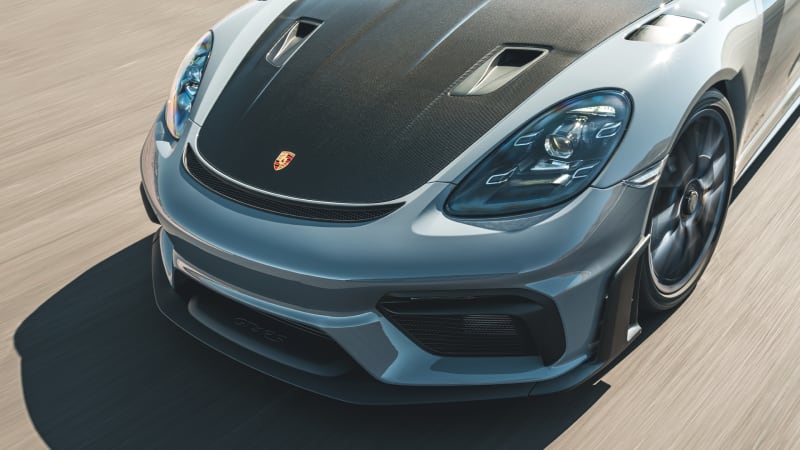
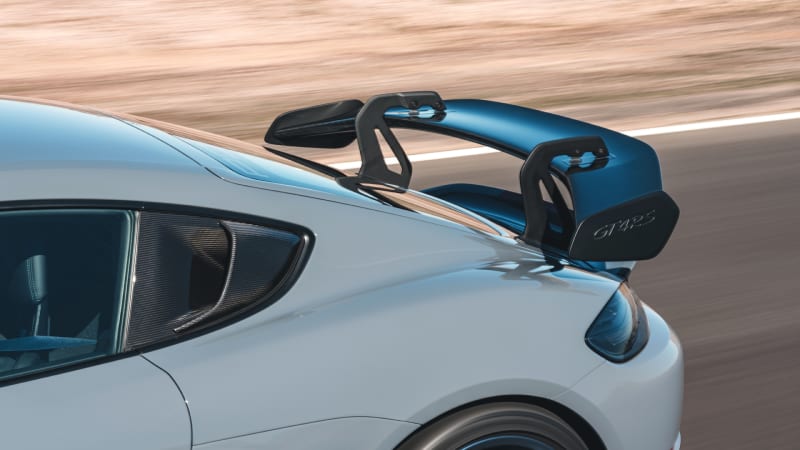
But there’s a lot more going on here than just an engine swap. Because that flat-six is mounted backwards relative to its orientation in the 911, engineers needed to develop a new seven-speed PDK gearbox specifically for the GT4 RS. It utilizes the same gear and axle ratios used in the previous-generation 911 GT3 RS PDK, which Porsche says effectively makes this the most aggressively-geared GT model produced thus far, while ancillary components like the dual-mass flywheel come directly from the GT4 Clubsport race car.
Supporting the beefed up powertrain is a host of chassis tweaks that include the integration of the previous-generation Carrera 4 front structure to improve rigidity, the use of ball joints for all the connection points on the front and rear axles, revised dampers, and increased spring rates all around. Stopping power is bolstered by the larger standard cast-iron front brakes from the GT3 with cooling enhancements provided by new wheel well air guides as well as the NACA ducts on the hood. That hood is made of a carbon fiber, by the way, as are the 911 GT1-inspired front fenders. On the aerodynamic front, enhancements like the adjustable front diffuser and swan neck rear wing also provide up to 25% more downforce than the standard GT4 at 125 mph.
Fixed-back carbon bucket seats come standard in the GT4 RS, but sport seats are also offered as a no-cost option. If you opt for the latter, however, I’d argue that you’re doing it wrong. These buckets are surprisingly comfortable despite the aggressive bolstering, and since they place you lower in the car, even taller drivers like myself can find an ideal seating position with a helmet on and still have headroom to spare.
With relatively short straights and tight corners, Streets of Willow tends to showcase a car’s chassis balance and contact patch more than anything else, but Porsche’s decision to run the track counter-clockwise threw an interesting curveball into the mix. After spending a lap getting re-acclimated while chasing Porsche factory driver Patrick Long in a 911 Turbo S, the pace quickly began to ramp up and it all started to make sense.
The layout allowed us to fly flat-out through the chicane leading up to the back straight, which effectively extended the length of that straight and allowed us to build up more speed before rapidly scrubbing it off and diving into the steep banking of the bowl that serves as the centerpiece of the course. From there it’s a series of increasingly demanding corners that test precision, patience, and grip before the course opens back up for a sprint back down onto the main straight.
I generally like to handle swapping the cogs myself, but with the rapid changes in speed and direction on this course, I opted to let the PDK do its own thing for the first few sessions. With fast, seamless shifts and near-clairvoyant programming in PDK Sport mode, the transmission dutifully kept the engine in the meaty parts of the powerband at all times for maximum response.
But doing so also leads to a lot of short shifts. For the sake of my own ego and a desire to hear that flat-six wind out to 9,000 RPM as often as possible, I decided to bump the shifter over to manual mode for a session later in the day to see how I’d fare on the paddles. Although nowhere near as efficient, it’s a significantly more involving and visceral experience since the noises only get better as the revs climb, and I discovered that the flat-six also has no trouble pulling the car out of slower corners with authority when you’re in a gear higher than what’s ideal.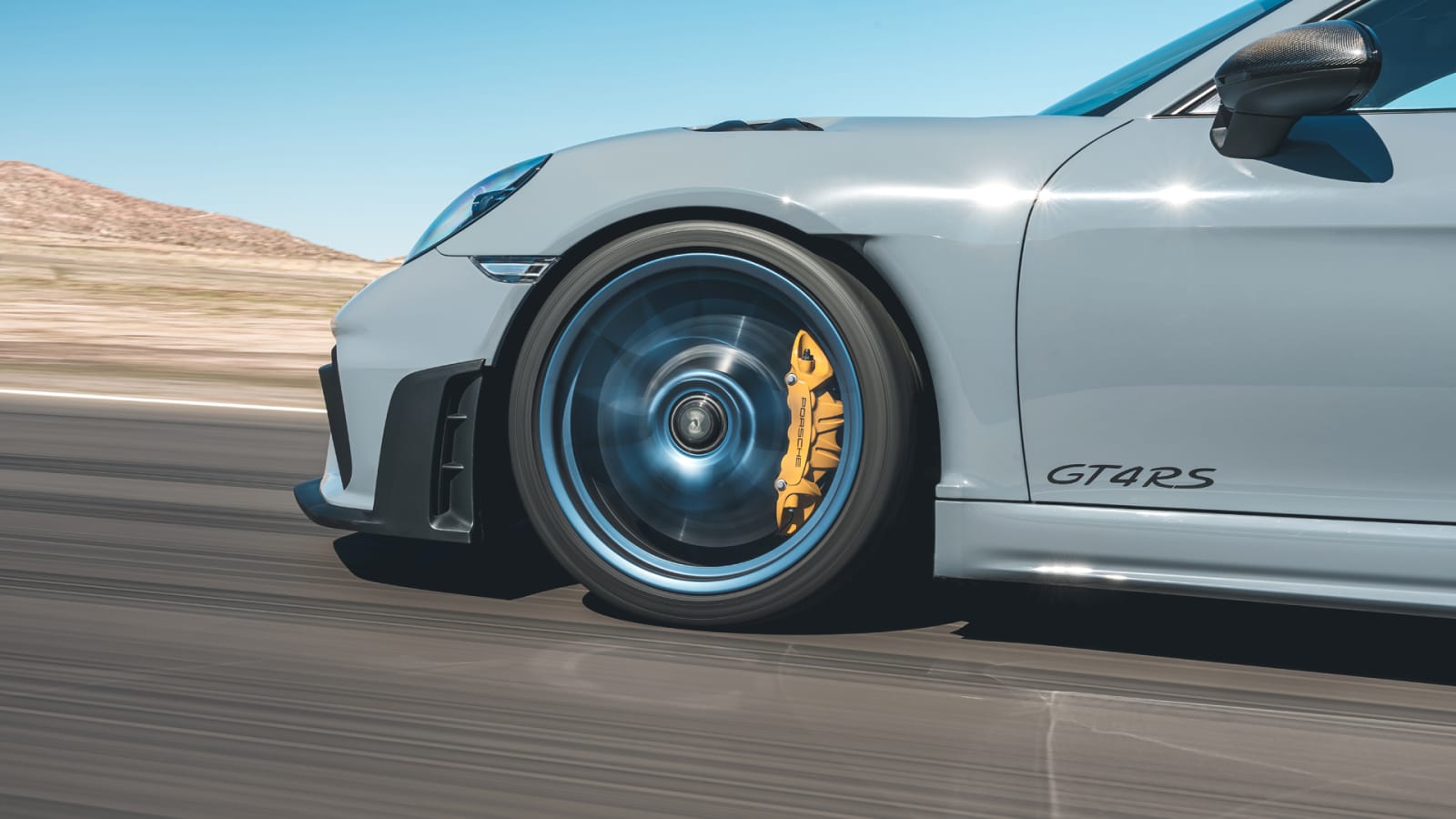
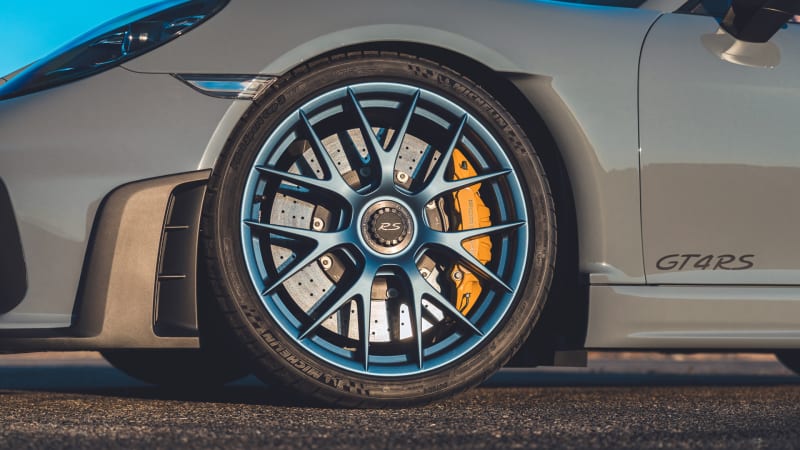
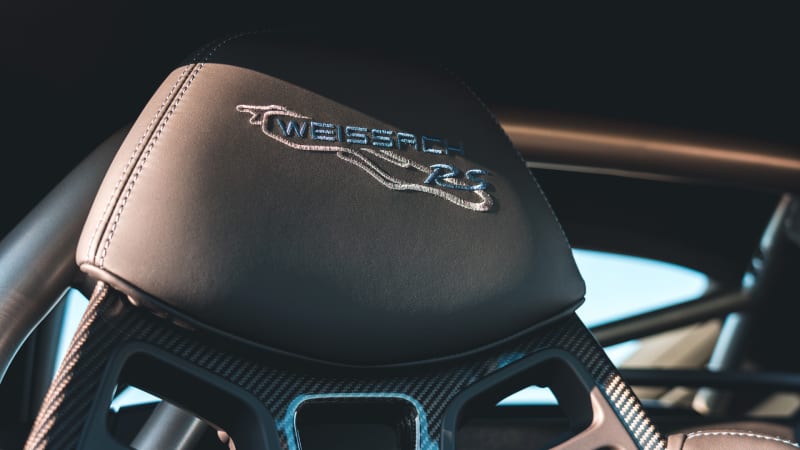
Porsche provided two different cars for our track sessions – one with the Weissach Package and another without. Although the enhancements are mainly cosmetic, opting for the Weissach Package allows buyers to check the box for the optional magnesium wheels that were fitted to the Arctic Grey example that you see here. While both cars were outfitted with the standard Michelin Pilot Sport Cup 2 tires (the even-stickier Pilot Sport Cup 2 R is available as a dealer-installed option), the benefit of the reduced rotating mass offered by those sharp-looking mags was evident thanks to more responsive initial turn-in and reduced ABS intervention in the big braking zones at the ends of the front and back straights.
Those Cup 2 Rs undoubtedly would have allowed for even greater pace, but the GT4 RS certainly isn’t lacking for grip without them. Paired with a quick, communicative steering rack and the unyielding stopping power of the optional carbon ceramic brakes, the car is a honed weapon on a race track that’s constantly providing information about what the tires and chassis are doing.
And there are no surprises: operating as though the driver is the center of mass, the GT4 RS is playful and approachable at the limit despite its aggressive tuning. While a 911 GT3 is a uniquely rewarding driving experience in part due to its engine placement, the Cayman GT4 RS is an intuitive instrument of speed that simply does exactly what you tell it to do. With a starting price that puts it in the same ballpark as the GT3 (when you’re this deep into six digits, $141,700 versus 161,100 qualifies), it seems inevitable that some will try to suss out which machine is ultimately the better sports car. Considering how closely matched the two are when it comes to outright performance, it’s largely a subjective endeavor.
One thing’s for sure, though: At a point in time when downsizing, turbocharging and hybridizing have become the order of the day, the GT4 RS philosophically stands in direct opposition to current automotive trends. And if concepts like the Mission R serve as foreshadowing, it’s clear that the future is on the way whether we’re ready for it or not. With that in mind, traditionalists would be wise to smoke ‘em while we’ve got ‘em.
Related Video:
Autoblog accepts vehicle loans from auto manufacturers with a tank of gas and sometimes insurance for the purpose of evaluation and editorial content. Like most of the auto news industry, we also sometimes accept travel, lodging and event access for vehicle drive and news coverage opportunities. Our opinions and criticism remain our own — we do not accept sponsored editorial.
Please sign in to leave a comment.
GM to offer U.S. Buick dealers buyouts
Here’s what a rental Tesla Model S interior looks like after 19,000 miles
Ford Mustang prototype mystery of ‘The Bulge’ finally solved
Arkansas town no longer allowed to give tickets after issuing too many
Junkyard Gem: 1981 Subaru GL 4WD Wagon
QuietKat Jeep E-Bike Review: Go almost anywhere on two wheels
News, Reviews, Photos, Videos
delivered straight to your in-box.
Thanks for subscribing.
Check your in-box to get started.
More Info
You must be logged in to perform that action.
Please enter a display name
